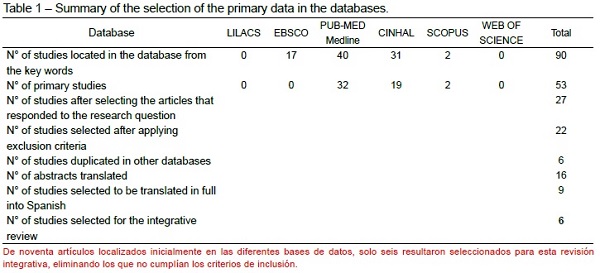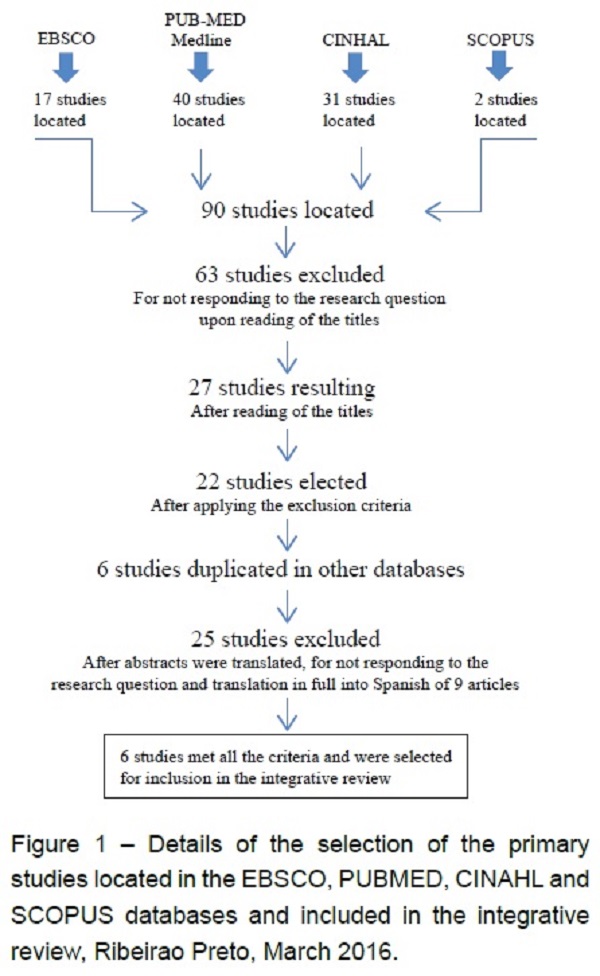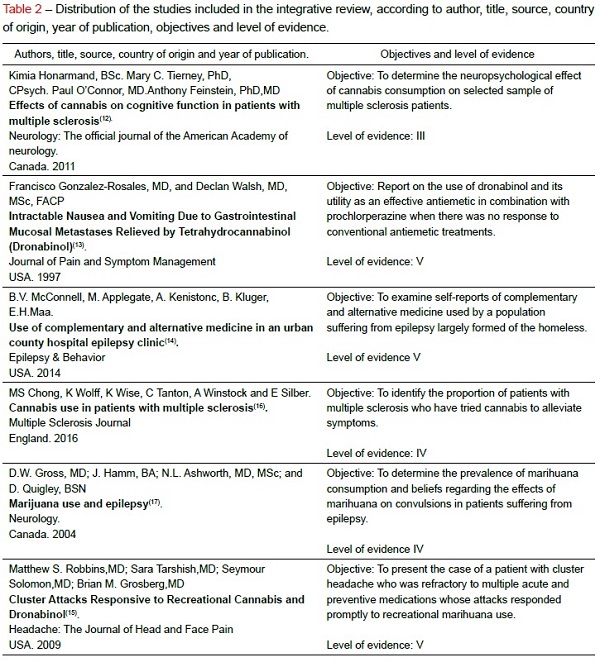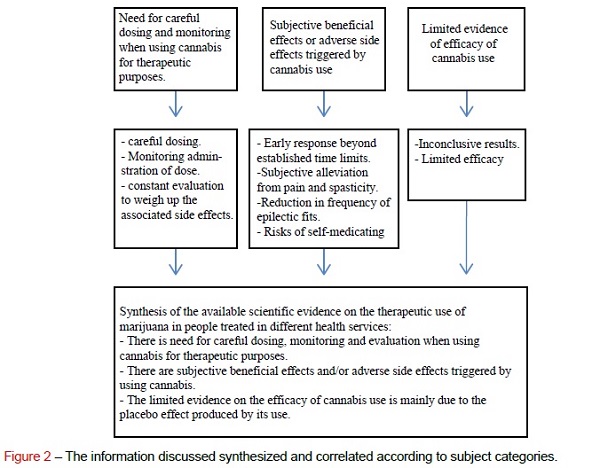Serviços Personalizados
Journal
artigo
Indicadores
Compartilhar
SMAD. Revista eletrônica saúde mental álcool e drogas
versão On-line ISSN 1806-6976
SMAD, Rev. Eletrônica Saúde Mental Álcool Drog. (Ed. port.) vol.13 no.3 Ribeirão Preto jul./set. 2017
https://doi.org/10.11606/issn.1806-6976.v13i3p167-174
REVIEW ARTICLE
DOI: 10.11606/issn.1806-6976.v13i3p167-174
Scientific evidence on therapeutic marihuana use in individuals treated in Health Care Services
Evidências científicas sobre o uso terapêutico da maconha para as pessoas que frequentam os serviços de saúde
Evidencias científicas sobre el uso terapéutico de marihuana a personas atendidas en Servicios de Salud
Leslie del Carmen Luza AcostaI; Carla Aparecida Arena VenturaII
IAssistant Professor, Escuela de Enfermeria, Universidad de Valparaíso, Valparaíso, Chile
IIAssociate Professor, Escola de Enfermagem de Ribeirão Preto, Universidade de São Paulo, PAHO/WHO Collaborating Centre for Nursing Research Development, Ribeirão Preto, SP, Brazil
ABSTRACT
The aim of this integrative review was to "identify, synthesize and evaluate the scientific evidence available on therapeutic marihuana use in those treated in health care services". The articles analyzed were selected from the following databases LILACS, CINAHL and MEDLINE and using tools such as WOS (Web of Science) and SCOPUS. After a broad search in Spanish, Portuguese and English, a total of ninety article were identified. The final selection consisted of six articles, four of which were primary articles and the other two were case studies. The analysis found that there are gaps in the evidence on the therapeutic effects of cannabis. Some positive effects are suggested, potentially useful in some cases, but probable adverse effects were also reported, it being therefore recommended that use of marihuana and marihuana-based products be weighed up depending on the pathologies present in the individual.
Descriptors: Marihuana, therapeutic use, health care services, health care centers.
RESUMO
Esta revisão integrativa tem como objetivo "identificar, sintetizar e avaliar a evidência científica disponível sobre o uso terapêutico da maconha em pessoas tratadas em diferentes serviços de saúde". Para a seleção dos artigos trabalhou no LILACS, CINAHL, MEDLINE, e outros como WOS (Web of Science) e de dados Scopus; após uma busca em idiomas, espanhol, português e inglês, foram identificadas noventa artigos. A seleção final seis artigos considerados; a análise mostra que existem lacunas na evidência sobre o efeito terapêutico da cannabis. Eles sugerem alguns efeitos positivos; uso dose recomendada de acordo com patologias presentes em pessoas.
Descritores: Maconha; Uso Terapéutico; Os Serviços de Saúde; Centros de Saúde.
RESUMEN
La presente revisión integrativa tiene como objetivos "identificar, sintetizar y evaluar las evidencias científicas disponibles sobre el uso terapéutico de marihuana en personas atendidas en diferentes servicios de salud". Para la selección de artículos a analizar se trabajó en las bases de datos LILACS, CINAHL, MEDLINE, y otras herramientas como WOS (Web of Science) y SCOPUS; posterior a una amplia búsqueda en idiomas, español, portugués e inglés, se logró identificar un total de noventa artículos. La selección final consideró seis artículos, cuatro de ellos, artículos primarios y dos estudios de casos; del análisis se observa que hay lagunas de evidencias sobre el efecto terapéutico de la cannabis. Se sugieren algunos efectos positivos, potencialmente útiles en algunos casos, pero también se refieren a los probables efectos adversos, por lo cual recomiendan medir el uso de la marihuana o productos derivados de ella, según patologías presentes en las personas.
Descriptores: Marihuana, uso terapéutico, servicios de salud, centros de salud.
Introduction
The possibility of drug use based on cannabis generates distrust and there are many doubts about the therapeutic use of marijuana. "Marijuana is a generic term used to refer to "Cannabis Sativa", an herbaceous species with psychoactive properties, and there is a history of use of C. sativa dating back to 4,000 years BC in China, to treat various conditions"(1). "Cannabis Sativa has approximately 489 components with more than 80 terpenophenolic compounds called cannabinoids, the rest are components such as terpenes, hydrocarbons, ketones, aldehydes and others, small hydrophobes able to cross the blood-brain barrier"(1).
In 1963 and 1964, chemical structures of Delta-9-Tetrahydrocannabinol (Δ9-THC), a psychoactive component of Cannabis and Cannabidiol (CBD), the two main compounds of Cannabis, were discovered. "Strain variability is given by the Δ9-THC/CBD index. The proportion of Δ9-THC has increased over time from 1-5% at the end of 1960 to current ranges of 10-15%, therefore, higher power psychoactive"(1).
In this context, cannabis "has a great interest in its medicinal use due to its anxiolytic, antiemetic, analgesic and anti-inflammatory properties"(2). "Different studies reveal the therapeutic effects with the use of cannabinoids: in the 1980s, several authors conducted clinical trials to compare the effectiveness of THC versus placebo or other antiemetic drugs in the treatment of nausea and vomiting caused by chemotherapy. These studies showed that THC is at least as effective as conventional therapy with dopamine antagonists"(2).
"According to research reviews, there is moderate or high-quality evidence compatible with the use of cannabis for some diseases, but not for others. After reviewing 80 randomized trials involving about 6,500 people, the authors found moderate support for the use of cannabis to treat pain and chronic muscle spasms, and involuntary movements"(3). "In 1995, in a Controlled Clinical Trial of a duration of 6 weeks, they evaluated the effects of dronabinol (synthetic THC presented in an oral capsule) in the increase of appetite and weight gain in patients with anorexia associated with the Acquired Immune Deficiency Syndrome (AIDS). Their results showed that dronabinol is safe and effective in this treatment"(4). The cannabinoids studied include smoking marijuana, orally administered cannabis extracts and cannabis-based medications such as Nabilone and Dronabinol.
In this way, in different countries, marijuana is already accepted as a therapeutic use to counteract the effects of some pathologies. Considering this context, this study focuses on the following question: What is the scientific evidence about the therapeutic use of marijuana in sick people treated in Health Services? To answer this question, an integrative review of the literature was conducted with the objectives of identifying, synthesizing and evaluating the available scientific evidence on the therapeutic use of marijuana in sick people treated in different health services.
Methodology
It is an integrative review, an "approach that allows the combination of different methodologies for example, experimental and non-experimental and tends to generate a coherent and global vision of the concepts and complex theories of health problems"(5). This review is developed according to six stages(6).
The first stage refers to the choice of the topic that presents the critic´s interest. In the development of the research question of this integrative review, the PICo strategy was used(7). The PICo, adheres as follows; P: for the population or problem - Description of the population or the study of the problem, I: for the phenomenon of interest - description of what will be investigated in the study and Co: for the context in which it occurs to study the phenomenon of interest. In this integrative review, the PICo strategy is presented as follows:
P: the sick
I : therapeutic marihuana use
Co: Health care services
As a result, the research question is: What are the scientific evidences about the therapeutic use of marijuana for sick people treated in health services?
For the inclusion of the articles, the criteria used were primary articles, full text, indexed journals, published in the Spanish, English, and Portuguese. Articles related to other types of drugs and those referring to drugs, in general, were excluded.
The Caribbean Health Sciences (LILACS), the Cumulative Index of Nursing and Allied Health Literature (Latin America and the CINAHL), the Medical Literature Analysis and the System On Line Recovery databases (MEDLINE) were used to select the primary studies and later expanding to the search with other tools such as WOS (Web of Science) and SCOPUS(8).
In the review of the primary studies that answer the research question, the combination of the Boolean descriptors represented by the AND and OR connective terms was used. As Keywords the terms applied were:
- Marihuana OR "Marijuana Medicinal" OR "Cannabis sativa"
- Therapeutic use
- Health care services OR "Health care centers"
- To broaden the search we included controlled descriptors (DeCS) as follows:
- Marihuana Medicinal (DECS) OR Cannabis sativa (DECS)
- Health care centers (DECS) OR Hospitals (DECS)
The different stages of the search were approached and reviewed by a librarian and the research question was the basis of the selection of studies to prepare this integrative review. Table 1 shows the summary of the selection of primary data in the databases.

To extract the information from the selected studies, a validated instrument(9) was applied and authorized by its creator, and with the following items: identification, objectives, methodological characteristics, results, and conclusions.
Along with the analysis of the selected articles, a classification was made according to criteria(10) which present classification systems of the evidence arranged hierarchically, depending on the methodological approach.
Based on the critical evaluation of the results of the studies included in the review, comparisons and conclusions were made besides the implications of the review.
After the data are presented, all the selected articles were originated in medical research, which allows the nursing professional to expand the knowledge about the therapeutic use of Marijuana, which could later allow questioning about what is the intervention of Nursing in the therapeutic use of this product.
Results
A search of primary articles that provided scientific evidence on the therapeutic use of marijuana in Spanish, Portuguese and English was carried out in the available databases. A total of ninety studies were located, corresponding to the EBSCO Databases, PUB-MED Medline, CINHAL, SCOPUS; LILACS and WEB OF SCIENCE did not yield results. Fifty-three of these ninety studies corresponded to primary studies, all in English. After the translation and reading of titles, twenty-seven articles correspond to the research topic: "Therapeutic use of marijuana to people assisted in Health Services". Five of the studies responded to exclusion criteria and six were duplicated in the different databases, leaving sixteen studies to translate the abstracts from English into Spanish, an instance in which seven articles were eliminated, which did not correspond to the inclusion criteria or they correspond to exclusion criteria. From this selection, nine articles were translated in full, evidencing that one article was not a primary study and another studied the side effects of the use of marijuana. The third studied the effect of Haloperidol in the presentation of cyclic vomiting product of marijuana use. Finally, six studies were selected and analyzed for this integrative review.
The figure below shows the stages of selecting the articles for this review.


When analyzing the six articles studied, three categories are extracted in common: Need for care with dosing and monitoring when cannabis is used for therapeutic purposes; Effects of subjective benefits or adverse side effects to trigger, and Limited evidence on their effectiveness.
Discussion
Need for care with dosing and monitoring when cannabis is used for therapeutic purposes.
The study "Intractable nausea and vomiting due to metastasis of the gastrointestinal mucosa relieved by tetrahydrocannabinol (Dronabinol)"(12) is a case study demonstrating that low doses of dronabinol can be safe and effective when used in combination with other antiemetics for intractable nausea and vomiting related to cancer. Dronabinol should be considered as a potentially useful agent in cases of intractable nausea and vomiting related to cancer without mechanical obstruction.
As well as the pain of patients with Multiple Sclerosis, neuropathic pain, nausea, and vomiting, there are the effects of some pathologies and/or treatments that affect the well-being of the patients, it was evidenced that the use of marijuana as a method to stop these problems is a success limited, influenced by the form of induction of the dosage, the dose and the follow-up by the specific risks for the consumption of cannabis. In this way, whatever the benefit is, its use must be balanced against the associated side effects.
The need for care with dosing and monitoring when cannabis is used for therapeutic purposes is addressed in an investigation conducted in the Neurology Sector of the Kings College Hospital in London, in the study "Cannabis Use in Patients with Multiple Sclerosis"(14) whose objective was to identify the proportion of patients with Multiple Sclerosis who have used cannabis for the control of symptoms. It is mentioned that cannabinoids seem to have an advantage in the reduction of pain in Multiple Sclerosis and neuropathic pain syndromes, taking precaution in the careful induction of dosing and monitoring when cannabis is used for therapeutic purposes. A small proportion experienced potentially serious adverse effects, including psychiatric symptoms and exhaustion.
Subjective beneficial effects or adverse side effects triggered by cannabis use
The study that addresses the use of marijuana in patients with multiple sclerosis(11) demonstrates a probable subjective relief of pain and spasticity; without evidence of clinical efficacy due to cannabis, whatever the benefit should be weighed against the associated cognitive side effects. Other research(13) conducted in the United States in 2014, based on self-reports of complementary and alternative medicine used by a population of 120 subjects older than 18 years old, with a diagnosis of epilepsy, 33% of respondents reported the use of marijuana and 54% of them mentioned a reduction in the frequency of crisis. However, because it was an observational study, it could not be assessed whether the efficacy described could be due to placebo effects.
The debate remains regarding the clinical efficacy of cannabinoids in the treatment of Multiple Sclerosis symptoms(14), it is reported that there may be risks of self-medication with one of the psychoactive substances by people with a neurological disease. This study also analyzed the specific risks for cannabis use, in particular, social factors, levels of disability and their perceived effects.
Since no compound with pharmacological action is totally healthy or toxic, cannabis, like any drug, can be a health risk if its doses are not carefully regulated and its therapeutic potential is monitored. The interaction with other drugs and balance benefit on adverse effects should also be identified.
The effects of subjective benefits or adverse side effects to be triggered by the use of cannabis were evidenced in three articles(13-14,16). Data on cannabis use among patients with a cluster headache are limited(16). In this case study, it is observed that the patient quickly showed an improvement of pain with 15 minutes of use which is faster than the reported occurrence of action of 30 to 60 minutes. This early response could represent a placebo effect. However, many treatments sensitive to attack, as well as the failure of other acute treatments, are proof against this phenomenon. They do not recommend the routine use of cannabis preparations either recreational or pharmacological preparations of cannabis for the treatment of cluster headaches, due to the risk of long-term dependence and other potential adverse effects.
Limited evidence of efficacy
One of the authors reviewed(13) reports that the issue of marijuana use in epilepsy is controversial, as it did not confirm the information regarding the efficacy in the use of marijuana, it does mention the limited evidence for epilepsy. Its use turned out to be a popular therapy in this population of patients, with 54% using marijuana considering it to be of clinical utility. Considering that it is an observational study, it could not be assessed whether the efficacy could be due to placebo effects, an information bias, other nonspecific effects, or direct anticonvulsant effects.
The limited evidence on efficacy by placebo effect was demonstrable in three of the articles reviewed(13-16). One of these studies suggests that cannabis use(15) is responsible for the early onset of pain improvement in a patient with Multiple Sclerosis could represent a placebo effect. In other research, most active users reported beneficial effects on seizures(15), with twenty-four percent of all subjects believing that marijuana was an effective therapy for epilepsy. Despite evidence of limited efficacy, many patients with epilepsy believe that marijuana is an effective therapy for epilepsy and are actively using it. The randomized controlled study was conducted to study the anticonvulsant effects of cannabidiol, and the results were inconclusive.

Final Considerations
This integrative review searching for scientific evidence on the therapeutic use of marijuana for people assisted in Health Services allowed verifying the scarce availability of primary scientific articles on the subject, particularly in the Spanish language. At the same time, it was found that nursing does not have publications related to the therapeutic use of marijuana. The most important findings are related to the existence of limited evidence of the efficacy of cannabis use or beneficial effects of the product, and this is mainly due to the placebo effect it produces. Adverse side effects that can be triggered by the use of cannabis generate the need for careful management follow-up and ongoing evaluation when cannabis is used for therapeutic purposes.
Acknowledgments
I would like to express my gratitude to the Nursing School of Ribeirão Preto of the University of São Paulo (EERP-USP) and the WHO Collaborating Center for the Development of Nursing Research and the National Secretariat for Drug Policy - SENAD for the possibility of carrying out this study and research in Alcohol and other Psychoactive Drugs. I thank the organizers for the welcome, the care and kindness of the planning in each phase of the course, and for the trust they placed in me by accepting me as part of the team of researchers. I give special thanks to my tutor who with patience and affection knew how to guide me and make this experience pleasant.
I thank the School of Nursing of the University of Valparaíso, Chile, for the facilities that were granted to me to do this training. I also want to wish the team great harmony and success in the coming courses, the work is tiring and we may not see the results immediately, but life is worth working to have a better world.
References
1. Venegas V. Legalización de la marihuana, la libertad que amenaza la salud pública. Rev Chil Pediatría. diciembre de 2014;85(6):653–7.
2. Parker L, Rock E, Limebeer C. Regulation of nausea and vomiting by cannabinoids. Br J Pharmacol. agosto de 2011;163(7):1411–22.
3. Asociación Internacional por el Cannabis como Medicamento [Internet]. [citado 24 de febrero de 2016]. Disponible en: http://www.cannabis-med.org/?lng=es
4. Beal JE, Olson R, Laubenstein L, Morales JO, Bellman P, Yangco B, et al. Dronabinol as a treatment for anorexia associated with weight loss in patients with AIDS. J Pain Symptom Manage. 1 de febrero de 1995;10(2):89–97.
5. Whittemore R, Knafl K. The integrative review: updated methodology. J Adv Nurs. 1 de diciembre de 2005;52(5):546–53.
6. Ganong L. Integrative reviews of nursing research. Res Nurs Health. 1 de febrero de 1987;10(1):1–11.
7. The Joanna Briggs Institute. Joanna Briggs Institute Reviewers Manual 2014 Edition [Internet]. [citado 6 de marzo de 2016]. Disponible en: http://joannabriggs.org/assets/docs/sumari/reviewersmanual-2014.pdf
8. Santos C, Pimenta C, Nobre M. Estrategia PICO para la construcción de la pregunta de investigación y la búsqueda de evidencias. Rev Lat Am Enfermagem. junio de 2007; 15(3):508-11.
9. Tavares M, Dias M, Carvalho R. Revisão integrativa: o que é e como fazer. Einstein São Paulo. 2010; 8:102–106.
10. Larcher MH, Palucci MH. A prática de enfermagem baseada em evidências: conceitos e informações disponíveis online. Rev Lat Am Enfermagem. agosto de 2000;8(4):103–4.
11. Honarmand K, Tierney M, OConnor P, Feinstein A. Effects of cannabis on cognitive function in patients with multiple sclerosis. Neurology. 29 de marzo de 2011;76 (13):1153–60.
12. Gonzalez-Rosales F, Walsh D. Intractable nausea and vomiting due to gastrointestinal mucosal metastases relieved by tetrahydrocannabinol (Dronabinol). J Pain Symptom Manage. 1 de noviembre de 1997; 14(5):311–4.
13. McConnell BV, Applegate M, Keniston A, Kluger B, Maa EH. Use of complementary and alternative medicine in an urban county hospital epilepsy clinic. Epilepsy Behav EB. mayo de 2014; 34:73–6.
14. Chong MS, Wolff K, Wise K, Tanton C, Winstock A, Silber E. Cannabis use in patients with multiple sclerosis. Mult Scler. 9 de enero de 2006; 12(5):646–51.
15. Gross DW, Hamm J, Ashworth NL, Quigley D. Marijuana use and epilepsy Prevalence in patients of a tertiary care epilepsy center. Neurology. 6 de agosto de 2004; 62(11):2095–7.
16. Matthew S, Robbins M, Tarshish S, Solomon S, Grosberg B. Cluster Attacks Responsive to Recreational Cannabis and Dronabinol. Headache J Head Face Pain. 1 de junio de 2009; 49(6):914–6.
Received: Dec. 01st 2016
Accepted: July 25th 2017
Corresponding Author:
Carla Aparecida Arena Ventura
Universidade de São Paulo
Escola de Enfermagem de Ribeirão Preto
Av. Bandeirantes, 3900
Bairro: Vila Monte Alegre
CEP: 14040-902, Ribeirão Preto, SP, Brasil
E-mail: caaventu@eerp.usp.br














